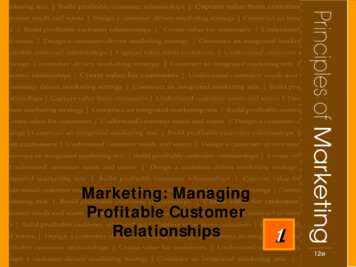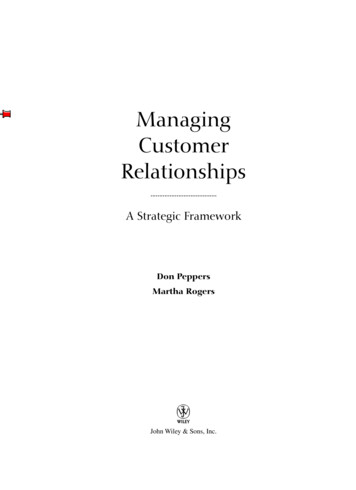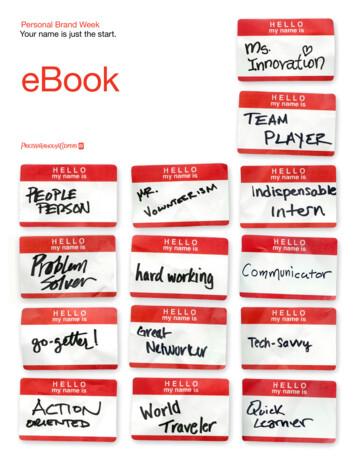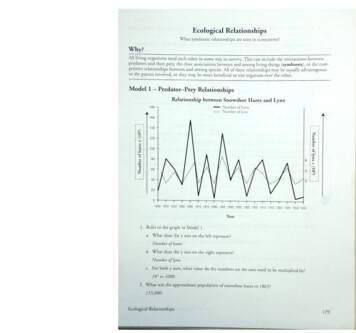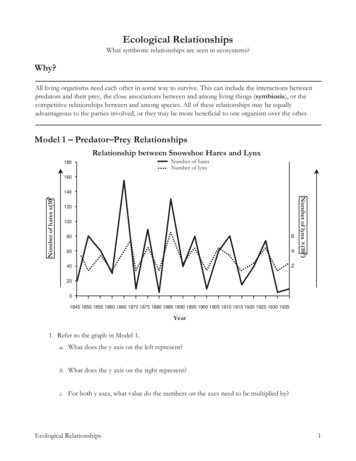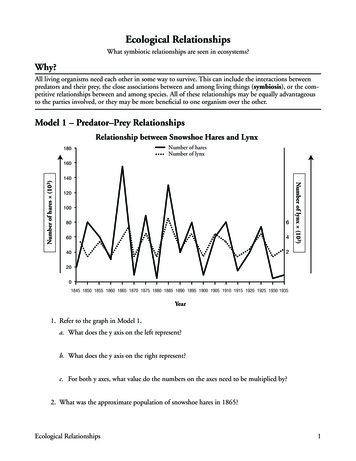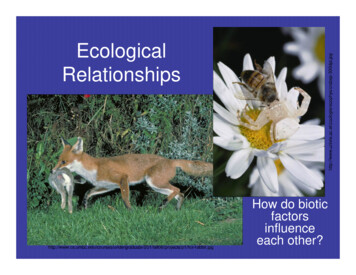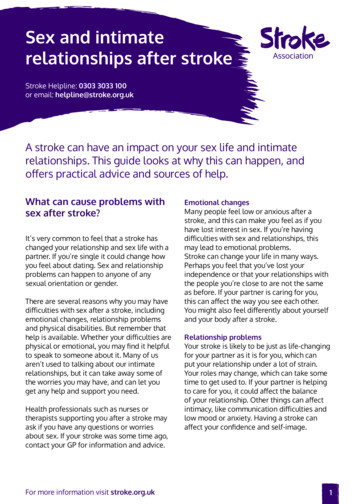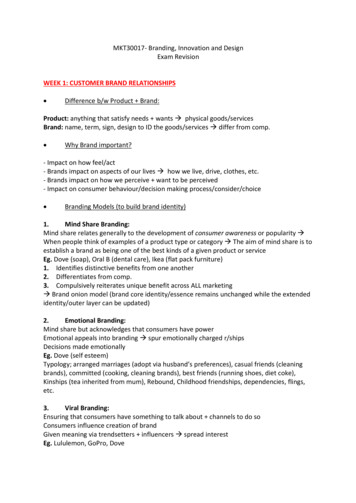
Transcription
MKT30017- Branding, Innovation and DesignExam RevisionWEEK 1: CUSTOMER BRAND RELATIONSHIPS Difference b/w Product Brand:Product: anything that satisfy needs wants à physical goods/servicesBrand: name, term, sign, design to ID the goods/services à differ from comp. Why Brand important?- Impact on how feel/act- Brands impact on aspects of our lives à how we live, drive, clothes, etc.- Brands impact on how we perceive want to be perceived- Impact on consumer behaviour/decision making process/consider/choice Branding Models (to build brand identity)1.Mind Share Branding:Mind share relates generally to the development of consumer awareness or popularity àWhen people think of examples of a product type or category à The aim of mind share is toestablish a brand as being one of the best kinds of a given product or serviceEg. Dove (soap), Oral B (dental care), Ikea (flat pack furniture)1. Identifies distinctive benefits from one another2. Differentiates from comp.3. Compulsively reiterates unique benefit across ALL marketingà Brand onion model (brand core identity/essence remains unchanged while the extendedidentity/outer layer can be updated)2.Emotional Branding:Mind share but acknowledges that consumers have powerEmotional appeals into branding à spur emotionally charged r/shipsDecisions made emotionallyEg. Dove (self esteem)Typology; arranged marriages (adopt via husband’s preferences), casual friends (cleaningbrands), committed (cooking, cleaning brands), best friends (running shoes, diet coke),Kinships (tea inherited from mum), Rebound, Childhood friendships, dependencies, flings,etc.3.Viral Branding:Ensuring that consumers have something to talk about channels to do soConsumers influence creation of brandGiven meaning via trendsetters influencers à spread interestEg. Lululemon, GoPro, Dove
4.Cultural Branding:Goal à build into cultural iconBrand used as symbolic resources for construction maintenance of identityBrand true to what stand for à followersEg. Nike, CaronaBrand Maturity:Mind-share à Emotional (focus on building brand elements foundations)à Viral à Cultural (Focus on managing brand meaning)
WEEK 2: BRAND EQUITY BRAND POSITIONINGStrong brands have EQUITY à the value a brand as vs. competing brandsà includes set of assets à stimulate higher price premiums OR extensions into othercategoriesà power of brand in mind of consumer à drives equity Customer-based brand equity:Brand knowledge on customer responseSuch as brand name, other elementsCan stimulate POSITIVE or NEGATIVE customer based brand equity Brand KnowledgeCreated through BRAND AWARENESS (recognition/recall) BRAND IMAGE (brandassociations)Customer based brand equity (CBBE) à when consumer high level of awareness holdsstrong, favourable and unique brand associations in memoryà establish brand awareness thru increase familiarity w/repeated exposureà create links in memory to cues, product categoriesRECOGNITION- confirm prior exposure w/cues (logo/symbol)RECALL- retrieve from memory when given cue “what brands do you like?” Brand ImagePerceptions associations w/brand held by customerMay be DIRECT (exposure via purchase/website) or INDIRECT (word of mouth/review) IVE Imageà STRONG, FAVOURABLE, UNIQUE ASSOCATIONS3 ASSOCIATIONS TO BRAND IMAGE:1.AttributesDescriptive features that characterize prod/service2 types:ØProduct relatedØNon-product related (price, packaging, user imagery/who uses, usage imagery/whenbeing consumed)2.BenefitsPersonal value consumers attach to prod/service attributes3 Types:ØFunctional (Gillette- close shave, Lean Cuisine- ready, low carbs)ØExperimental (Sensory exp/what is gained by consumption à Magnum- indulgentexp./treat)ØSymbolic (underlying values à Rolex- symb. Benefits of wealth sense ofaccomplishment)3.Attitudes
Consumers overall evaluation of brandGenerally favourable/ ive or –ive judgement towards brandFormed as RESULT of attributes AND/OR benefits of brandWhen dealing w/brand image à marketers should consider 3 Q’s:1.Strength “how firmly are such associates held in memory?”2.Favourability “associates desirable to consumers?”3.Uniqueness “Do associations effectively distinguish one brand from comp.offerings?”Brand image (audience focused created by perceptions of consumer) NOT identity(company focused created by managerial activities) Brand positioningDesigning brands OFFERING IMAGE so occupies distinct valued place in targetconsumers mind à clarifies what brand about what’s unique about brand giving REASONto purchase3 Q’s when designing POSITIONING STRATEGY:1.Have we established frame? (target market competitors prod. category)2.Are we leveraging our points of parity (POP’s) à similar across brands EG bankATMS, loan facilities, etc3.Are the points of difference (POD’s) compelling? à unique to brand à Desirability Deliverability criteriaNB Updating positioning overtime (evolving)à extension of positioning brand mantras (3-5 word phrases à “heart and soul” andusually internally to motivate and stay true to essence3 componentsEmotional modifier (benefits) EG Nike “advanced athletic performance”Descriptive modifier (nature) EG McDonalds “Fun fast/family food”Brand function EG Betty Crocker “homemade made easy”
WEEK 3: BRAND RESONANCE KELLER 4 steps to brand development1.Brand Identity “Who are you?”Ensure ID of brand w/customers association of brand in consumers mind w/in prod.category2.Brand Meaning “What are you?”Establish brand meaning in minds à link to specific associations w/brand to consumersknow what brand stands for3.Brand Response “What about you? What do I think I feel about you?”Elicit proper response to brand ID meaning à manage thoughts feelings about brand4.Brand Relationships “what about you and me? What kind of associations would Ilike to have w/you?”Convert brand response to create intense, active, loyal r/ship w/consumer brandà to apply these steps 6 FUNDAMENTAL BUILDING BLOCKSthe goal to reach pinnacle achieve brand resonanceStages of Brand Development (L) à RATIONAL THINKING/COGNITIVE APPROACH(salience, performance, judgements, resonance)Branding Objectives (R) à EMOTIONAL APPROACH(salience, imagery, feelings, resonance)
Ø SalienceProbability that brand will be recalled early in consideration (top-mind awareness)Key dimensionsà depth of brand awareness (ease of which brand can be recalled/recognised)à breadth of brand awareness (range of purchase consumption situations in w/brandcomes to mind) the brand must not only be TOP OF MIND have sufficient MIND SHARE, but do so atright time and placesØ PerformanceWay product/service attempts to meet functional needsCritical à impacts customer exp. what they hear about brandPerformance dimensions:- Primary characteristics supplementary features- Product reliability, durability, serviceability- Service effectiveness, efficiency, empathy- Style design- Priceà strength in any of these point of differenceEG. VW (park assist), Dyson (vac design)- ImageryExtrinsic properties of product/service influencing ways brand attempts to meetpsychological social needsCore dimensions of imagery:- User profiles (include demographic- age, gender, race, etc.)- Purchase usage situations (eg. Seasonal implications)- Personality and values- History and heritageEG. Nikon à brand story “TEARS” combines history heritage w/different usagesituations- Brand PersonalitySet of human characteristics associated w/brand à 5 CORE DIMENSIONS1. SINCERITY (down to earth, honest, cheerful) eg. DOVE2. EXCITEMENT (daring, spirited, imaginative, up to date) eg. REDBULL3. COMPETENCE (reliable, intelligent, successful) eg. DHL EXPRESS4. SOPHISTICATION (upper class, charming) eg. MERCEDES BENZ5. RUGGEDNESS (outdoorsy, tough) eg. EVERLAST
- Judgements FeelingsDeal w/how customers RESPOND to brandJUDGEMENTS: responses arise from ‘HEAD’4 Types:1. Quality (content materials)2. Credibility (expertise, trustworthiness, likeability?)3. Consideration (willing to consider?)4. Superiority (better than comp?)FEELINGS: responses arise from ‘HEART’6 Types:1. Warmth2. Fun eg. Disney3. Excitement eg. Redbull4. Security eg. Volvo5. Social Approval eg. Mercedes “made it”6. Self-respect eg. Body Shop “feel good about self”- ResonanceNature of r/ship customers have w/brandGoal good, long lasting so personally identify w/brand4 key ways customers resonate w/brand:1. Behavioural Loyalty (repeat purchases, fav brand)2. Attitudinal Loyalty (personal attachment)3. Sense of Community (feel kinship/affiliation eg. Apple)4. Active Engagement (willing to invest resources beyond purchase)EXAMPLES:
Dove (soap), Oral B (dental care), Ikea (flat pack furniture) 1. Identifies distinctive benefits from one another 2. Differentiates from comp. 3. Compulsively reiterates unique benefit across ALL marketing à Brand onion model (brand core identity/essence remains unchanged while the extended identity/outer layer can be updated) 2. Emotional Branding: Mind share but acknowledges that consumers .
